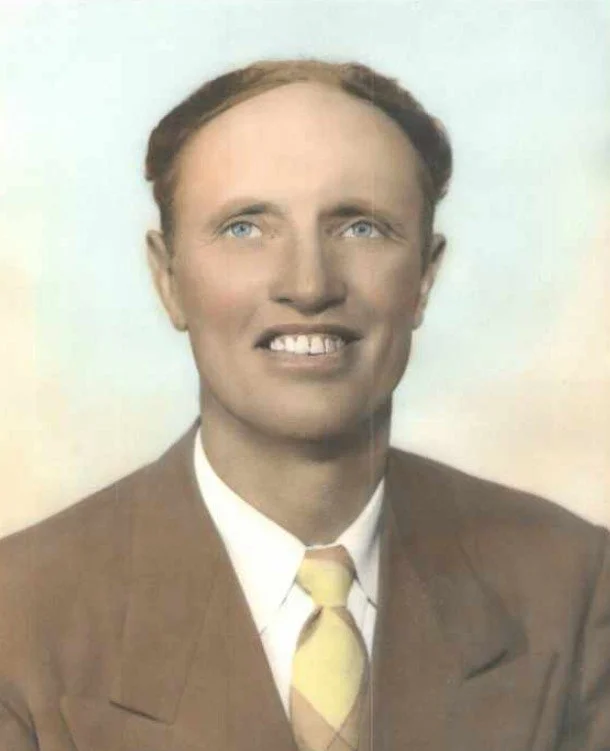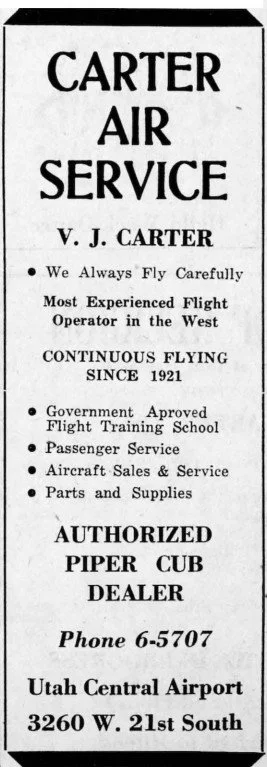Barnstormer to Builder: Vern ‘Lehi’ Carter and the Utah Central Airport in Granger
The Utah Central Airport was between 3200-3600 West on 2100 South
Verenus “Vern” Joseph Carter: Pioneer Aviator and Airport Founder
Verenus Joseph “Vern” Carter was one of Utah’s true aviation pioneers, a man who spent his life in the cockpit and whose career mirrored the growth of flight from fragile biplanes to the jet age.
Born in Lehi, Utah, Carter came of age just as aviation was taking hold in the post–World War I years. At that time, pilots had to do just about everything themselves—mechanic, flight instructor, stunt performer, and showman. Barnstorming was one of the only ways to make a living, and Carter embraced the gypsy-like lifestyle of the era. He flew into county fairs and celebrations across the West, offering short-hop rides, lessons, and aerial stunts to thrill the crowds. To draw business he often risked his life with daredevil feats—wing walking, parachute jumps, and even stunt flying in a John Wayne movie titled Wings.
In 1929, Vern married Jesse Ellen Welsh, who shared his love of aviation. Remarkably, Jesse also earned her pilot’s license, and together they raised nine children while building a life centered on flying.
Over the years, Carter flew almost every job imaginable. He worked for Tommy Thompson’s flying service, for National Parks Airways, and later for Western Airlines. He transported the sick and injured to hospitals in emergency flights, patrolled mountain ranges counting elk, and even taught aviation to students who spoke little or no English—using interpreters and hand signals when necessary. For Carter, one of his greatest joys came not from the stunts or paychecks, but from watching his students succeed: “I’ve always liked to work with students,” he said, “and it’s a great pleasure to follow their progress.” Many of his pupils went on to careers in aviation around the world.
In 1936, Carter took a bold step that would cement his place in Utah aviation history. He purchased a large tract of land at 2100 South and 3400 West in Salt Lake County and established the…….
Utah Central Airport
which he owned and operated for 18 years. It became a hub for general aviation and training in the Salt Lake Valley during the 1930s and 1940s.
His vision didn’t stop there. In 1948, he purchased additional land on the Lake Bonneville bench in Draper, opening the Carter Sky Ranch in 1950. Later, he expanded again with the purchase of property in Lehi, where he established yet another airport.
Carter also brushed shoulders with aviation legends. While flying in Los Angeles, he and fellow pilots attended a navigation class taught by the renowned Philip Van Horn Weems, a pioneer in aerial navigation. During the course, a tall, slim young man entered with a special request. The pilots were invited to stay and listen as this visitor learned—his name was Charles A. Lindbergh, preparing for his historic solo flight across the Atlantic. Carter later recalled the experience with awe, having witnessed history in the making.
Through a long career that stretched from the days of Jenny biplanes to the dawn of jetliners, Vern Carter never lost his enthusiasm for flying. From barnstorming crowds at county fairs to building airports that anchored aviation in Utah, his life’s work left a lasting mark. For him, the greatest thrill was not in the stunts or the fame, but in watching aviation grow and in hearing a former student say, “Because of you, I made it in flying.
On August 18, 1966, while tending to the work he loved at the Utah Central Airport hangar, Vern Carter passed away suddenly. Fittingly, he spent his final moments surrounded by the planes and flying community that had defined his life
1932
1947
1948














